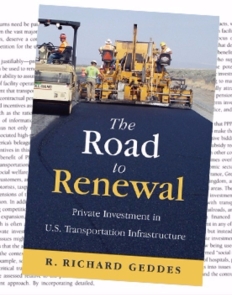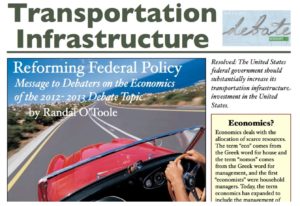Previous Astounding Ideas/Economic Thinking posts include:
• Free Money for Freeways: Notes on Federal Transportation Reform (2017)
• Federal Space Transportation: Time for Reform (2017)
• Paying for Transportation Infrastructure (2013)
• John Stossel and Drew Carey on Transportation (2013)

For an overview on federal transportation policy reforms also recommended is this 20-minute December 2016 AtlanticLIVE online video: The Next Infrastructure Agenda / Summit on Infrastructure and Transportation. Richard Geddes is featured on the video, directs the Cornell Program in Infrastructure Policy, and is author of The Road to Renewal: Private Investment in U.S. Transportation Infrastructure (2011).
Another resource for debaters is Robert Poole of the Reason Foundation. Poole has long researched and published on federal transportation policy reforms. Here is the Reason Foundation Transportation page, and here is a recent post, “How and Why to Toll the Interstates that Need Reconstruction,” (June 9, 2017).
There are mountains of transportation policy research for students to navigate and explore. But first step back and review the economics of transportation, from ocean and river, to road and rail, to air and even space transportation.
In all cases resources devoted to transportation are scarce. That is, money spent to improve rail, highways, ports, airports, and spaceports comes from taxpayers, investors, or the people and firms using transportation services and infrastructure (often through gas taxes and fees).
Repairing, expanding, or building new highways, bridges, transit, or ports has a cost, but it’s also costly to not repair, expand, or build. When people and freight can’t get from here to there, spending hundreds of hours each year stuck in traffic, that has a high cost as well. “Tolling the Freeway: Congestion Pricing and the Economics of Managing Traffic,” (Mercatus Center, May 5, 2016), reports:
Traffic congestion continues to increase in the United States. A trip that would typically take 20 minutes in free-flowing traffic may now take 48 minutes during peak driving times. …These delays are costly, both in terms of drivers’ time and because of air pollution. Congestion is estimated to have cost the United States $160 billion in 2014.
And this figure doesn’t measure the full social costs of congested freeways. My father lives 25 minutes away if I-405 from Renton to Bellevue was managed to allow free-flowing traffic. Instead I-405 is congested most of the day and the trip usually taking 35-45 minutes. My friend Steve lives another ten minutes away along this route. Because of traffic congestion I visit far less than I would otherwise. This hidden cost of traffic congestion is altering people visits to family and friends isn’t captured in studies that measure increased commute to and from work and longer commercial transportation costs.
Economists recommend private property, markets, and prices to coordinate free societies, and especially to address traffic congestion. Movie theaters charge higher prices at peak movie going times (Friday and Saturday evenings), and hotels charge higher rates when demand for hotel rooms is highest. Prices send signals to consumers and those who can at least cost adjust their plans do so, avoiding movie theaters and hotels when higher prices signal higher demand.
These price signals would relieve highway congestion as well:
Congestion pricing, also known as variable tolling, offers a solution. Congestion pricing means the highway toll changes based on the number of drivers using the road. Travelers respond to the higher tolls by shifting nonessential trips to a different time or by carpooling, thus reducing congestion.
 Here is an overview study guide pdf on federal transportation infrastructure prepared for the 2012 NSDA national debate topic.
Here is an overview study guide pdf on federal transportation infrastructure prepared for the 2012 NSDA national debate topic.
